Writing Application Letters
Writing Application Letters. What you’re sending,why you’re sending it and how the reader can benefit from reading your material Be specific Never volunteer salary information unless an employer asks for it Keep it short Show some personality Aim for high quality.
Share Presentation
Embed Code
Link
Download Presentation
- meeting
- unsolicited application letter
- interpersonal skills
- writing application letters
- what sort
- relate skills
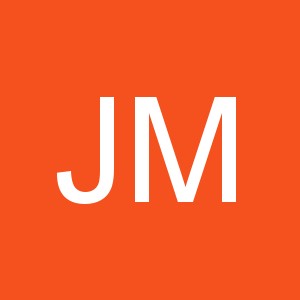
june + Follow
Download Presentation
Writing Application Letters
An Image/Link below is provided (as is) to download presentation Download Policy: Content on the Website is provided to you AS IS for your information and personal use and may not be sold / licensed / shared on other websites without getting consent from its author. Content is provided to you AS IS for your information and personal use only. Download presentation by click this link. While downloading, if for some reason you are not able to download a presentation, the publisher may have deleted the file from their server. During download, if you can't get a presentation, the file might be deleted by the publisher.
Presentation Transcript
- Writing Application Letters • What you’re sending,why you’re sending it and how the reader can benefit from reading your material • Be specific • Never volunteer salary information unless an employer asks for it • Keep it short • Show some personality • Aim for high quality
- Solicited versus Unsolicited • Solicited Application Letter: In response to an announced job opening, should know requirements of the organization • Unsolicited Application Letter: To an organization that has not announced an opening. Focus on the needs of the employer, start by capturing the reader’s attention and interest
- Organizing Application Letters • Getting Attention:Use AIDA (Attention-Interest-Desire-Action) approach, focus on your audience & emphasize reader benefits => Opening paragraph: 1. Clearly state your reason for writing 2. Give a recipient a reason to keep reading
- Organizing Application Letters • Middle Section: Expand on your opening, present a more complete picture of your strengths • Final Paragraph: Respectfully ask for specific action and make it easy for the reader to respond
- Application Follow-Ups • If application letter and resume fail to bring a response within a month, write to keep your file active • If kept on file, don’t hesitate to send a follow-up letter 3 months later to show that you’re still interested showing that: You’ve continued to add to your skills or that you’ve learned more about the company or the industry
- Interviews • Discussion with a purpose • Include facial expressions, eye contact, gestures & posture • May cause misunderstanding & confusion => develop strong interviewing skills
- Understanding the Interview Process • Employment Interviews have a dual purpose: • Finding the best person available for the job • Your main objective: Finding the best job suitable for your goals & capabilities
- Typical Sequence of Interviews • Stages: I) Screening Stage: Campus, invitation of the candidates for further evaluation, similar questions, standardized “evaluation” , Get-to-know-you interviews. • Follow the interviewer’s lead; keep your responses short, differentiate yourself from others, emphasize the “theme” you used in developing your CV.
- II) Selection Stage: • Will talk with several people • Show interest in the job • Relate your skills & experience to the organization’s needs • Listen attentively • Ask insightful questions • Display enthusiasm
- III) Final Stage: • May receive a job offer • May be invited back for final evaluation • Underlying objective: Selling you on the advantages of joining the organization
- Common Types of Interviews 1) Structured Interview: Screening • Asking a series of prepared questions in order. • Answers noted • Poor measure of applicant’s quality • But create uniformity in hiring process
- 2) Open-ended Interview • Less formal & unstructured with a relaxed format • Open-ended questions, encourages you to talk freely • Good for bringing out your personality & testing professional judgment
- 3) Group Interviews • Meeting with several candidates to see how they react • Useful for judging interpersonal skills 4) Stress Interview: Help recruiters see how you handle yourself under pressure; Pause for a few seconds to collect your thoughts, then continue knowing what the interviewer is up to.
- 5) Video Interview • Videoconferencing systems to screen middle-management candidates • To interview new recruits at universities • Speak clearly but not more slowly than normal • Look up but not down • Sit straight • Arrive early enough to get used to the equipment
- 6) Situational (Behavioral) Interview • You’re asked to explain how you would handle(d) a specific set of circumstances • No correlation exists between how well people answer traditional interview questions & how well they perform on the job => Each job requires different mix of personality traits; Interviewer’s task is to find out whether you will be effective on the job.
- What employers look for in an interview? • Suitability for the specific job is judged on the basis of: • Academic preparation • Work experience • Job-related personality traits
- Preemployment Testing • Integrity tests: For ethical or legal issues • Personality tests: Used to assess general character or suitability for the demands of a specific situation • Job skills tests: Assess the competency to perform a job • Substance tests: Drug & alcohol testing • Background tests: Verifying credentials in CV, learning if you have a criminal history etc.
- Preparing for a job interview: • Will help you perform better under pressure • Consider any cultural differences • Base your approach on what your audience expects I) Learn about the organization
- II) Think ahead about questions: A) Planning for the Employer’s Questions: Your skills, achievements, goals, attitudes toward work & school, relationships with others, hobbies & interests or; (Table 15-2) • What was the hardest decision you ever had to make? • What are your greatest weaknesses? • What didn’t you like about previous jobs you’ve held? • Where do you want to be five years from now? • Tell me something about yourself
- B) Planning questions of your own: • You are responsible for deciding whether the work and the organization are compatible with your goals & values. Are these my kind of people. Examples: • Can I do this work? • Will I enjoy the work? • Is the job what I want? • Does the job pay what I’m worth? • What kind of person would I be working for? • What sort of future can I expect with this organization?
- B) Planning questions of your own: • You don’t necessarily wait until the interviewer asks if you have any questions of your own; look for smooth ways to work prepared questions into the conversation • Impress the interviewer with your ability to organize be thorough by bringing a list of questions • Table 15-3
- Bolster Your Confidence • Make a better impression & make the whole process less stressful • Emphasize positive traits (warmth, wit, intelligence, charm) • Instead of dwelling your weaknesses focus on strengths
- Polish you Interview Style • Competence & confidence are the foundation of your interviewing style • Enhance these by giving the interviewer an impression of poise, good manners & good judgment • Role-playing, videotaping or audiotaping • Nonverbal behavior; Eye contact, sit in attentive position, use frequent hand gestures => alert, assertive, dependable, confident, responsible & energetic: U.S. • Sound of your voice; the way you speak • Avoid: You know, like, um etc. Table 15-4
- Plan to Look Good • Dress conservatively (dark, solid color) and be well groomed • You DON’T need to spend a fortune on new clothes, but you do need to look clean, prepared and professional. • One of the best ways to look good is to smile at appropriate moments • Make professional appearance and habits a routine part of your day after you had the job; Meeting times, t-shirts etc. => sign of mutual respect
- Be Ready when you arrive • Take a small notebook, a pen, list of the questions you want to ask, 2 copies of CV, outline of what you have learned about the organization • May also take your transcript, list of references, portfolio containing samples of your work, performance reviews, certificates of achievement • Arrive early & relax, bring stg. business-related to read. If opportunity available, express enthusiasm for the job. Checklist
- Interviewing for success • Present a memorable “headline” at the screening stage • Cover all your strengths during selection stage; touch briefly on all your strengths, but explain 3 or 4 of your best qualifications • Emphasize your personality during a final interview
- Every interview has these stages: I)The Warm-up: Most important, 20 sec. • Body language is important • Hand shaking • Seating • Let the interviewer start the discussion • Listening cues telling you what the interviewer is interested in knowing about you as a potential employee.
- II) The Question-and-Answer Stage • Questions & answers consume the greatest part of the interview • Dealing with questions: Let the interviewer lead the conversation, NEVER answer a question before he/she has finished asking it • Listening: Paying attention to both verbal & nonverbal messages help you • Fielding discriminatory questions: Related to your qualifications, information- personal, responding. • Table 15-5
- III) The Close: • Concluding the interview with courtesy & enthusiasm • Discussing salary: Research salary ranges in your job, industry & geographic region before • Negotiating benefits may be one way to get more value from an employment package • Checklist
- Interview Notes • Keep a written record of your job interviews • Briefly summarize the interviewer’s answers to your questions • Evaluate your performance during the interview
- Following up after the interview 1) Thank-you-message: Express your thanks within 2 days • Acknowledge the interviewer’s time and courtesy, convey your continued interest and then ask politely for a decision • Keep your message brief and organize it like a routine message • Sound positive without sounding overconfident. Figure 15-3
- 2) Message of Inquiry • If not taken an answer by the promised date or within 2 weeks • Appropriate if received a job offer from a second firm • Follow the model for a direct request
- 3) Request for a time extension • Preface your request with a friendly opening; ask for more time, stressing your enthusiasm for the organization • Conclude by allowing for a quick decision if your request for additional time is denied • Ask for a prompt reply confirming the time extension if the organization grants it • Direct request, but be careful to show your continued interest.
- 4) Letter (e-mail) of acceptance • When you receive a job offer that you want to accept, reply within 5 days • Begin by accepting the position & expressing thanks • Cover any necessary details • Conclude by saying that you look forward to reporting for work • Be careful: Legally binding contract • Positive letter: Should convey your enthusiasm & eagerness to cooperate
- 5) Letter declining a job offer • The model for negative messages • Open warmly, state the reasons for refusing the offer • Decline the offer explicitly & close on a pleasant note, expressing gratitude • By taking the time to write a sincere, tactful letter, you leave the door open for future contact.
- 6) Letter of resignation • Should always be written in a gracious & professional style that avoids criticism of your employer or your colleagues • Follow the bad news plan & make the letter sound positive • Say stg. favorable about the organization, people or what you’ve learned in the job • State your intention to leave & give the date of your last day on the job • Give at least 2 weeks notice Checklist
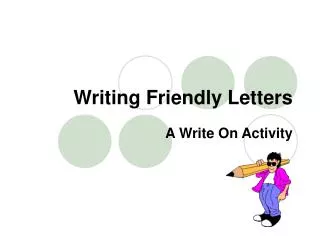
Writing Friendly Letters
Writing Friendly Letters. A Write On Activity. Friendly letters have five parts:. The Heading The Salutation (greeting) The Body The Closing The Signature. Heading. The Heading.
234 views • 7 slides
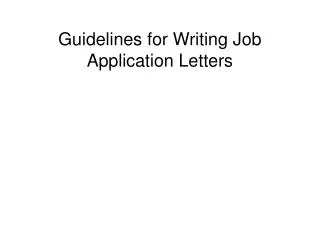
Guidelines for Writing Job Application Letters
Guidelines for Writing Job Application Letters. Guidelines for Writing Job Application Letters. Personalize your letter for that company. Know the job ad and respond specifically to what is in it. Avoid an excessive use of the first-person pronoun.
524 views • 11 slides
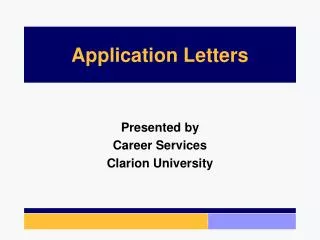
Application Letters
Application Letters. Presented by Career Services Clarion University. Purpose of a Cover Letter. Catch the reader’s attention Focus on the employer’s needs Persuade the reader of your benefits or value Convince the reader with evidence Move the reader to follow-up with you …interview you!.
432 views • 23 slides
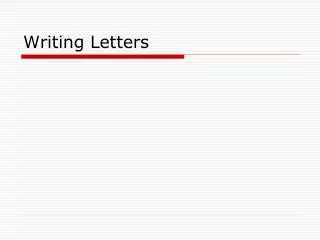
Writing Letters
Writing Letters. Types of Letters. Four common types of business correspondence: Inquiry letters Special request letters Sales letters Customer relations letters. Inquiry Letters. Inquiry letters ask for information about a product, service, publication, or procedure.
733 views • 27 slides

Application Letters
Application Letters. What is an application letter?. Application letter are used as a means to seek employment.
727 views • 14 slides
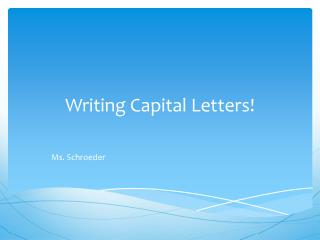
Writing Capital Letters!
Writing Capital Letters!. Ms. Schroeder. A. A stands for. B. B stands for. C. C stands for. D. D stands for. E. E stands for. F. F stands for. G. G stands for. H. H stands for. I. I stands for. J. J stands for. K. K stands for. L. L stands for. M. M stands for. N.
425 views • 28 slides

Writing Letters
Writing Letters. By Megan Rees. Parts of a Letter. Part One. Letters Consist of Parts:. Date Mailing Address Salutation Body Complimentary Close Signature. January 28, 2008. DATE. Mariella Monroe 14 Appletree Lane New Orleans, LA 41255. MAILING ADDRESS. SALUTATION.
722 views • 25 slides
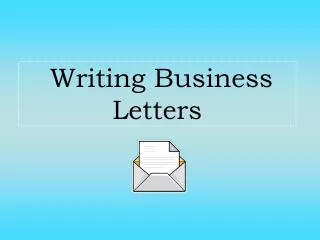
Writing Business Letters
Writing Business Letters. Six parts of the Business letter. The heading The inside address The salutation The body The closing The signature. The Heading. Your street address Your city, state, and ZIP code The date the letter was written. Example:. 4561 Easy Street Agoura, CA 99303
836 views • 17 slides

WRITING LETTERS
WRITING LETTERS. LETTERS. STRUCTURE OF THE LETTER. Address Date Greeting ( Dear…) Introduction (1 opening remarks)
335 views • 8 slides
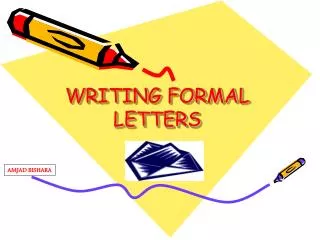
WRITING FORMAL LETTERS
WRITING FORMAL LETTERS. AMJAD BISHARA. IN ORDER TO WRITE GOOD LETTERS YOU NEED WRITING SKILLS. PURPOSE. LOGICAL ORDER. AUDIENCE. TONE. WRITING SKILLS. CONTENT. SPELLING. STRUCTURE. STYLE. WE CAN DIVIDE LETTERS INTO THREE MAIN KINDS, DEPENDING ON:.
569 views • 13 slides
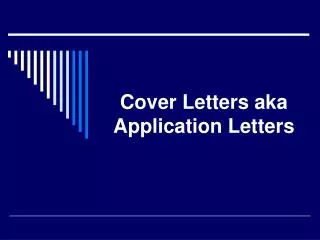
Cover Letters aka Application Letters
Cover Letters aka Application Letters. Purpose of a Cover Letter. Provides a snapshot of your personality Conveys professionalism Demonstrates written communication skills Highlights skills and experience. Guidelines for Cover Letters. Keep it short – no more than 1 page
321 views • 10 slides

Writing Letters
Writing Letters. Friendly letters have five parts:. The Heading The Salutation (greeting) The Body The Closing The Signature. Heading. The Heading.
294 views • 15 slides

Writing Letters
Writing Letters. The aim of my presentation is. getting students to understand the differences between formal and informal letters; help students master differences in register required for writing in English; prepare students for taking the state exam. Formal Moscow,Russia March,24,2011
579 views • 20 slides

Writing Friendly Letters
Writing Friendly Letters. A Write On Activity. Friendly letters have five parts:. The Heading The Greeting The Body The Closing The Signature. Heading. The Heading. The heading can include your address and the date. In casual, friendly letters your address is not necessary.
243 views • 7 slides
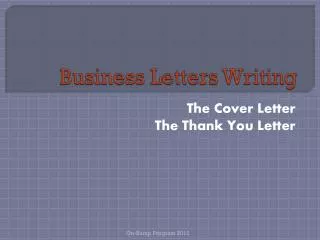
Business Letters Writing
Business Letters Writing. The Cover Letter The Thank You Letter. The Cover Letter. A cover letter is a document sent with your resume to provide additional information on your skills and experience.
347 views • 26 slides

WRITING LETTERS
WRITING LETTERS. Are you sure you know how?. Why would we want to send letters?. There are no due dates – you can send them whenever you wish! It’s fun to get letters in return!. Plus…. When you get a letter you can read it anytime and enjoy it over and over again!.
388 views • 23 slides
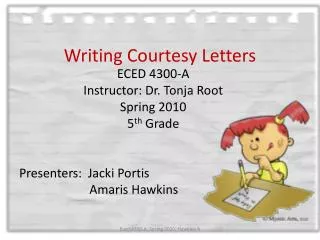
Writing Courtesy Letters
Writing Courtesy Letters. ECED 4300-A Instructor: Dr. Tonja Root Spring 2010 5 th Grade Presenters: Jacki Portis Amaris Hawkins. Jacki Portis-- Prewriting/Drafting.
435 views • 20 slides
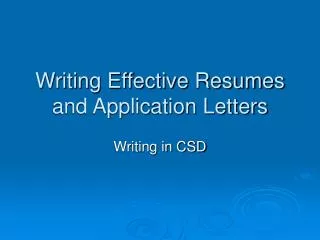
Writing Effective Resumes and Application Letters
Writing Effective Resumes and Application Letters. Writing in CSD. How not to get the job/ How not to get accepted. Little or no knowledge of the company/organization/program Unprepared to discuss skills and experience Unprepared to discuss career plans and goals Limited enthusiasm
183 views • 6 slides
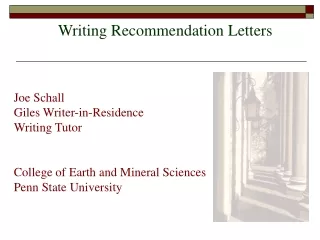
Writing Recommendation Letters
Writing Recommendation Letters. Joe Schall Giles Writer-in-Residence Writing Tutor College of Earth and Mineral Sciences Penn State University. My Background. B.S., Juniata College, Huntingdon, PA, English Education M.A., Penn State, English, Fiction Writing Emphasis
434 views • 40 slides

Writing Friendly Letters
Writing Friendly Letters. Friendly letters have five parts:. The Heading The Salutation (greeting) The Body The Closing The Signature. Heading. The Heading. The heading includes your address and the date. You do not always need your address. The heading goes on the top right corner.
244 views • 20 slides

Writing Letters
Writing Letters. Tamyra Horst. Leadership Certification Course - Level 1. A good letter begins with the paper it’s written on Letters written for your ministry should be written on letterhead When creating your own letterhead, invest in good paper. Fonts that are easy to read. Arial
341 views • 25 slides























